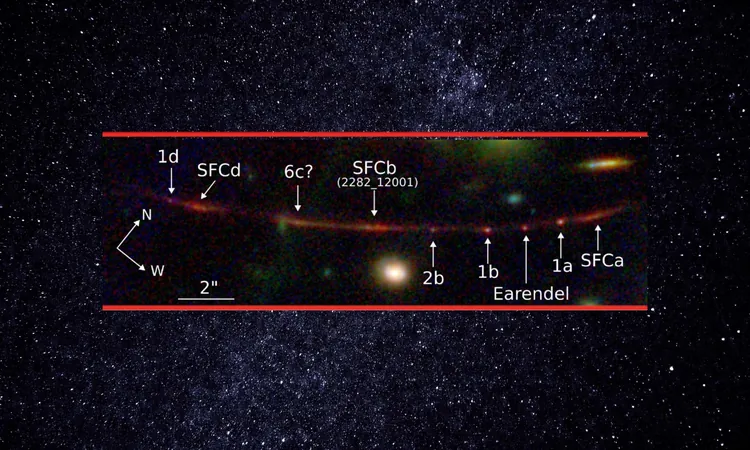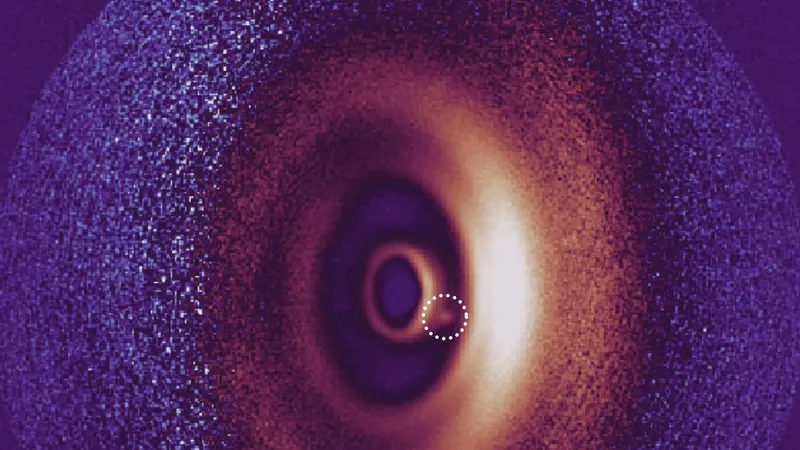
Earendel: The Distant Star That's Not What We Thought
2025-08-31
Author: Benjamin
Astronomers have made a surprising discovery about Earendel, the most distant star known to humanity, located a staggering 12.9 billion light-years away. This celestial beacon emitted its light when the Universe was less than a billion years old, but new findings suggest that Earendel may not be a solitary star after all.
A Cosmic Mystery Unveiled
Recent observations from the James Webb Space Telescope (JWST) indicate that Earendel could actually be a compact group of stars held together by gravity. If this theory is confirmed, it will revolutionize our understanding of how ancient star clusters formed and how they contribute to our observations of the early Universe.
Revisiting an Enigma
Led by researcher Massimo Pascale from the University of California, Berkeley, a team reexamined Earendel, as initial findings from the Hubble Space Telescope left room for multiple interpretations. The star appeared at redshift 6.2, approximately 900 million years after the Big Bang. However, the complexity of Earendel's light, magnified by a foreground galaxy cluster, warranted further investigation.
Gravitational Lensing: Nature's Telescope
Gravitational lensing, a cosmic phenomenon caused by massive objects bending space-time, allowed astronomers to study Earendel in great detail. The latest JWST findings revealed a magnification factor exceeding 4,000, making the star appear brighter and more compact than it truly is.
What the JWST Revealed
Utilizing JWST’s NIRSpec instrument, researchers captured a smooth spectrum across near-infrared wavelengths. These observations allowed for an in-depth analysis of Earendel’s brightness, uncovering possibilities that align more closely with a star cluster rather than a single star.
The Hunt for Clarity
While the evidence leans toward a star cluster, caution remains essential. Microlensing—temporary light fluctuations caused by smaller masses passing in front of the light source—could provide valuable insights. Should Earendel exhibit steadier brightness than expected for a single star, it will bolster the cluster hypothesis.
Connecting the Dots With Early Star Formation
If confirmed as a cluster, Earendel might represent a progenitor of the dense globular clusters we see in nearby galaxies today. This discovery could provide a unique glimpse into star formation under the intense conditions of the early Universe, revealing how these ancient stellar systems began to assemble.
Why This Matters
Rare cosmic alignments like that of Earendel allow astronomers to observe incredibly faint objects, illuminating our understanding of the Universe's infancy. These insights are crucial for refining models of stellar evolution and early galaxy formation, making each observation a treasure trove of knowledge.
What Lies Ahead for Earendel
Astronomers will continue to monitor Earendel for signs of microlensing and conduct higher-resolution spectral analyses. Enhanced observations will help separate the contributions of potential stellar companions, bringing clarity to what was once merely a nickname.
With ongoing advancements in observational technology and methodologies, the journey to fully understand Earendel is just beginning, promising thrilling revelations about the dawn of the cosmos.









 Brasil (PT)
Brasil (PT)
 Canada (EN)
Canada (EN)
 Chile (ES)
Chile (ES)
 Česko (CS)
Česko (CS)
 대한민국 (KO)
대한민국 (KO)
 España (ES)
España (ES)
 France (FR)
France (FR)
 Hong Kong (EN)
Hong Kong (EN)
 Italia (IT)
Italia (IT)
 日本 (JA)
日本 (JA)
 Magyarország (HU)
Magyarország (HU)
 Norge (NO)
Norge (NO)
 Polska (PL)
Polska (PL)
 Schweiz (DE)
Schweiz (DE)
 Singapore (EN)
Singapore (EN)
 Sverige (SV)
Sverige (SV)
 Suomi (FI)
Suomi (FI)
 Türkiye (TR)
Türkiye (TR)
 الإمارات العربية المتحدة (AR)
الإمارات العربية المتحدة (AR)